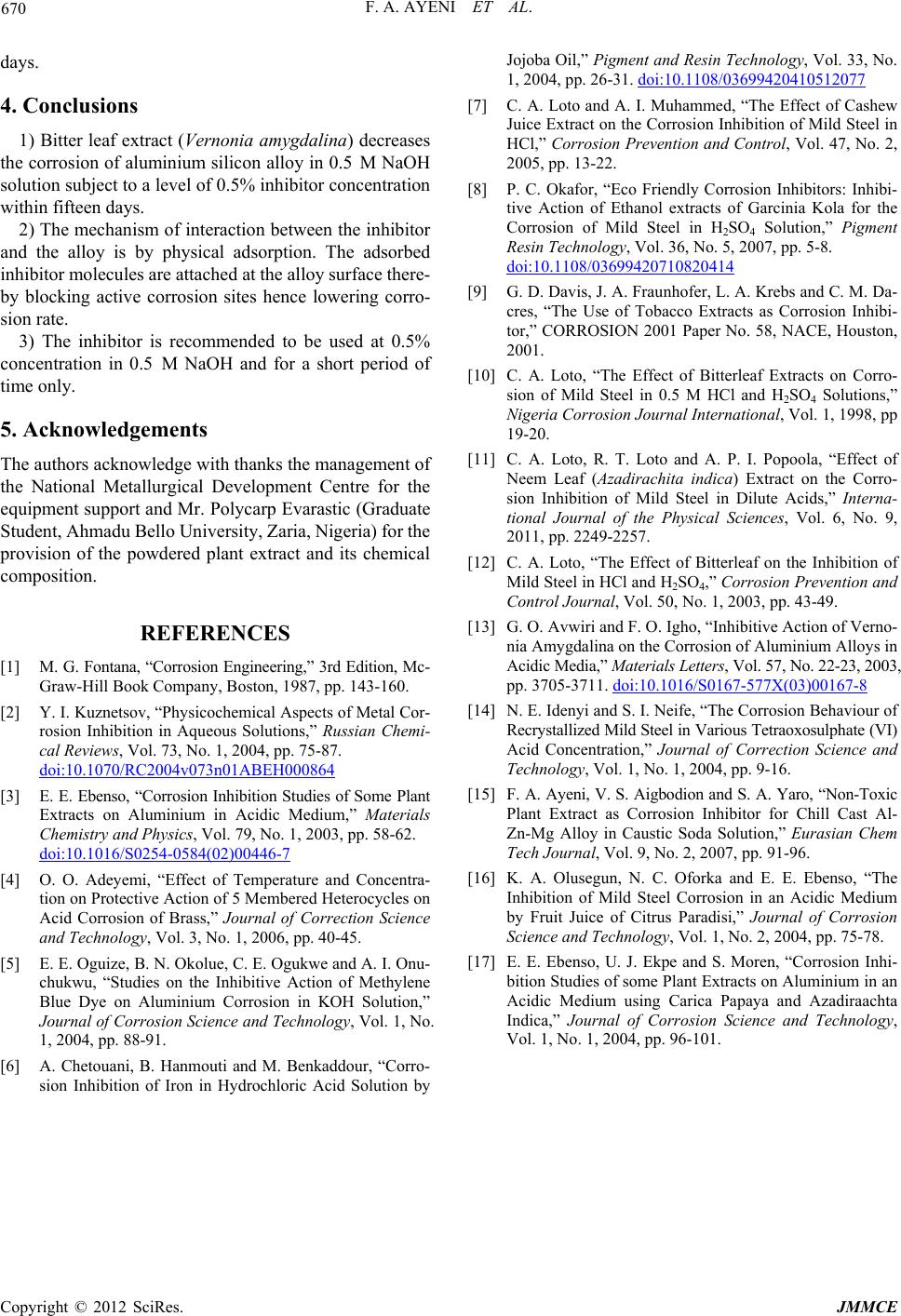
F. A. AYENI ET AL.
Copyright © 2012 SciRes. JMMCE
670
days.
4. Conclusions
1) Bitter leaf extract (Vernonia amygdalina) decreases
the corrosion of aluminium silicon allo y in 0.5 M NaOH
solution subj ect to a level of 0.5% inhib itor con centration
within fifteen days.
2) The mechanism of interactio n between the inhibitor
and the alloy is by physical adsorption. The adsorbed
inhibitor molecules are attached at the alloy surface there-
by blocking active corrosion sites hence lowering corro-
sion rate.
3) The inhibitor is recommended to be used at 0.5%
concentration in 0.5 M NaOH and for a short period of
time only.
5. Acknowledgements
The authors acknowledge with thanks the management of
the National Metallurgical Development Centre for the
equipment support and Mr. Polycarp Evarastic (Graduate
Student, Ahmadu Bello University, Zaria, Nigeria) for the
provision of the powdered plant extract and its chemical
composition.
REFERENCES
[1] M. G. Fontana, “Corrosion Engineering,” 3rd Edition, Mc -
Graw-Hill Book Company, Boston, 1987, pp. 143-160.
[2] Y. I. Kuznetsov, “Physicochemical Aspects of Metal Cor-
rosion Inhibition in Aqueous Solutions,” Russian Chemi-
cal Reviews, Vol. 73, No. 1, 2004, pp. 75-87.
doi:10.1070/RC2004v073n01ABEH000864
[3] E. E. Ebenso, “Corrosion In hibition Studies of Some Plant
Extracts on Aluminium in Acidic Medium,” Materials
Chemistry and Physics, Vol. 79, No. 1, 2003, pp. 58-62.
doi:10.1016/S0254-0584(02)00446-7
[4] O. O. Adeyemi, “Effect of Temperature and Concentra-
tion on Protective Action of 5 Membered Heterocycles on
Acid Corrosion of Brass,” Journal of Correction Science
and Technology, Vol. 3, No. 1, 2006, pp. 40-45.
[5] E. E. Oguize, B. N. Okolue, C. E. Ogukwe and A. I. Onu-
chukwu, “Studies on the Inhibitive Action of Methylene
Blue Dye on Aluminium Corrosion in KOH Solution,”
Journal of Corrosion Science and Technology, Vol. 1, No.
1, 2004, pp. 88-91.
[6] A. Chetouani, B. Hanmouti and M. Benkaddour, “Corro-
sion Inhibition of Iron in Hydrochloric Acid Solution by
Jojoba Oil,” Pigment and Resin Technology, Vol. 33, No.
1, 2004, pp. 26-31. doi:10.1108/03699420410512077
[7] C. A. Loto and A. I. Muhammed, “The Effect of Cashew
Juice Extract on the Corrosion Inhibition of Mild Steel in
HCl,” Corrosion Prevention and Control, Vol. 47, No. 2,
2005, pp. 13-22.
[8] P. C. Okafor, “Eco Friendly Corrosion Inhibitors: Inhibi-
tive Action of Ethanol extracts of Garcinia Kola for the
Corrosion of Mild Steel in H2SO4 Solution,” Pigment
Resin Technology, Vol. 36, No. 5, 2007, pp. 5-8.
doi:10.1108/03699420710820414
[9] G. D. Davis, J. A. Fraunhofer, L. A. Krebs and C. M. Da-
cres, “The Use of Tobacco Extracts as Corrosion Inhibi-
tor,” CORROSION 2001 Paper No. 58, NACE, Houston,
2001.
[10] C. A. Loto, “The Effect of Bitterleaf Extracts on Corro-
sion of Mild Steel in 0.5 M HCl and H2SO4 Solutions,”
Nigeria Corrosion Journal International, Vol. 1, 1998, pp
19-20.
[11] C. A. Loto, R. T. Loto and A. P. I. Popoola, “Effect of
Neem Leaf (Azadirachita indica) Extract on the Corro-
sion Inhibition of Mild Steel in Dilute Acids,” Interna-
tional Journal of the Physical Sciences, Vol. 6, No. 9,
2011, pp. 2249-2257.
[12] C. A. Loto, “The Effect of Bitterleaf on the Inhibition of
Mild Steel in HCl and H2SO4,” Corrosion Prevention and
Control Journal, Vol. 50, No. 1, 2003, pp. 43-49.
[13] G. O. Avwiri and F. O. Igho, “Inhibitive Action of Verno-
nia Amygdalina on the Corrosion of Aluminium Alloys in
Acidic Media,” Materials Letters, Vol. 57, No. 22-23, 2003,
pp. 3705-3711. doi:10.1016/S0167-577X(03)00167-8
[14] N. E. Idenyi and S. I. Neife, “The Corrosion Behaviour of
Recrystallized Mild Steel in Various Tetrao xosulphate (VI)
Acid Concentration,” Journal of Correction Science and
Technology, Vol. 1, No. 1, 2004, pp. 9-16.
[15] F. A. Ay eni, V. S. Aigbodion and S. A. Yaro, “Non-Toxic
Plant Extract as Corrosion Inhibitor for Chill Cast Al-
Zn-Mg Alloy in Caustic Soda Solution,” Eurasian Chem
Tech Journal, Vol. 9, No. 2, 2007, pp. 91-96.
[16] K. A. Olusegun, N. C. Oforka and E. E. Ebenso, “The
Inhibition of Mild Steel Corrosion in an Acidic Medium
by Fruit Juice of Citrus Paradisi,” Journal of Corrosion
Science and Technology, Vol. 1, No. 2, 2004, pp. 75-78.
[17] E. E. Ebenso, U. J. Ekpe and S. Moren, “Corrosion Inhi-
bition Studies of some Plant Extracts on Aluminium in an
Acidic Medium using Carica Papaya and Azadiraachta
Indica,” Journal of Corrosion Science and Technology,
Vol. 1, No. 1, 2004, pp. 96-101.